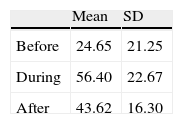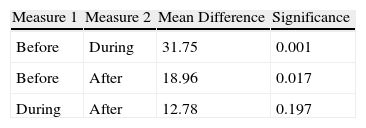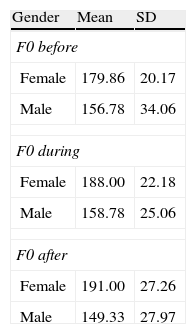The purposes of this study are to demonstrate the use of the mobile voice lab in type I thyroplasty with Gore-Tex® using analysis of spectrogram and fundamental frequency in the operating room, and also to show how to do this procedure.
MethodsVoice samples were recorded in the operating room immediately before and during type I thyroplasty. Six-week postoperative samples were also taken in the voice laboratory. Fundamental frequency and spectral analysis were analyzed. Spectrograms were evaluated by a blind panel of 4 judges on a 100mm visual analogue scale. All three time points were compared and statistical analysis performed. Pre and postoperative V-RQOL scores were also compared.
ResultsSignificant improvement in spectrogram ratings were seen between before and during (P<.001), and before and after voice samples (P<.017). There was no significant difference between during and after scores, suggesting the persistence of the intraoperative improvement in this measure. Changes in fundamental frequency were not statistically significant, although fundamental frequency tended to increase in women and decrease in men after type I thyroplasty. Mean V-RQOL scores improved from 48.08 to 85.08 (P<.001).
ConclusionsThe mobile voice laboratory may be useful during type I thyroplasty with Gore-Tex®. It offers an opportunity for the surgeon and voice pathologist to continue to collaborate in the treatment of patients with unilateral vocal fold paralysis.
Los objetivos de este estudio fueron la demostración del uso del laboratorio móvil de voz durante la tiroplastia tipo I con Gore-Tex®, utilizando análisis de espectrograma y frecuencia fundamental en el quirófano, además de mostrar el modo de realización de este procedimiento.
MétodosLas muestras de voz fueron grabadas en la sala de operaciones inmediatamente antes, y durante la tiroplastia tipo I. También se tomaron muestras 6 semanas después de la cirugía. Se realizó un análisis de la frecuencia fundamental, y un análisis espectral de la voz. Los espectrogramas fueron evaluados por 4 jueces externos, utilizando una escala visual de 100 mm. Se compararon los 3 puntos temporales (antes, durante y después), y posteriormente se realizó un análisis estadístico. Adicionalmente se realizó una comparación de las puntuaciones del cuestionario V-RQOL pre y poscirugía.
ResultadosSe obtuvo una mejoría significativa de los valores de los espectrogramas tomados antes y durante la cirugía (p<0,001), y antes y después de la cirugía (p<0,017). No hubo diferencia entre las muestras tomadas durante y después, resaltando la importancia de la mejoría intraoperatoria de esta medición. Los cambios en la frecuencia fundamental no fueron estadísticamente significativos, aunque este parámetro mostró una tendencia al incremento en mujeres y una disminución en varones tras la tiroplastia. El promedio del cuestionario V-RQOL experimentó un incremento de 48,08 a 85,08 (p<0,001).
ConclusionesLos resultados muestran que el laboratorio móvil de voz puede ser útil durante la tiroplastia tipo I con Gore-Tex®. Esta herramienta ofrece una oportunidad de colaboración conjunta entre el cirujano y el logopeda en el tratamiento de pacientes con parálisis unilateral de cuerda vocal.










